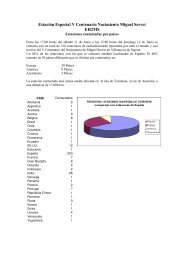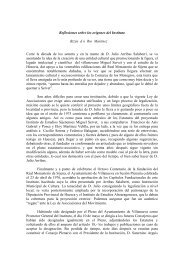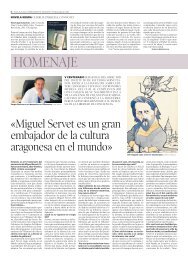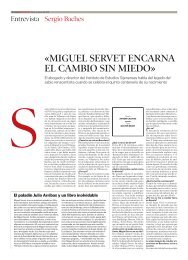New Page
New Page
New Page
You also want an ePaper? Increase the reach of your titles
YUMPU automatically turns print PDFs into web optimized ePapers that Google loves.
work, this detail is somehow lost in the above conceptions. And if the presence of the ideas of Restitutio<br />
can be indicated in an important chapter of the representative Polish--Hungarian Antitrinitarian work as<br />
well as in the respective vernacular publications, the forceful emphasis on the element of reinterpretation<br />
will be justified. All this, of course, is remarkable with respect to the later history of Servet's work and<br />
will modify the view now dominant in the literature on the subject that the work of the mature Servet had<br />
no significant reception.123<br />
Looking for the Leitmotif of the treatment one probably thinks of the moral philosophical discussions<br />
in the source work. On the level of moral theology both works put forward an imitatio Christi based<br />
ultimately on the <strong>New</strong> Testament and allowing several interpretations. This and the god--man relationship<br />
fundamentally changed after the appearance of the Man Jesus Christ can be regarded as the common<br />
element that made the use of Restitutio possible even if opinions radically differed concerning the<br />
previous status of Jesus Christ. Thus the new Christology could be viewed as one that puts the moral<br />
theology formulated by Servet on a more solid and more consistent basis. At least that is the dominating<br />
tendency in the works of Grzegorz Pawel. In Rövid útmutatás, however, a more complicated situation<br />
should be expected. It will perhaps have been made clear by the analysis above that while the Polish<br />
Antitrinitarian had a clarified, clear cut and Christological position, this was not the case with Ferenc<br />
Dávid at all. Although, on the one hand, it can be said that by translating the crucially important parts of<br />
Brevis explicatio into Hungarian he eliminated a considerable amount of the obscurities and ambivalences<br />
in the earlier works but, on the other, he did not give up the idea of trying to reconcile Lelio Sozzini's<br />
Christology with that of Servet, the latter cleansed of the Platonic traits. The denial of Christ's<br />
preexistence became the basic tenet of his dogmatics, but through the ample use of the text of Restitutio<br />
he embraced details reminiscent of the +old" concept. As we have said, these are not to be regarded as<br />
transient phenomena and as it will be shown, it is exactly the dogged insistence on Servetian phraseology<br />
that makes his views individual.<br />
All this makes one pause to think about the hermeneutical procedures formulated and followed in<br />
Ferenc Dávid's work. We have seen that getting acquainted with the procedure followed in Brevis<br />
explicatio did not solve for him the tormenting questions of interpreting the Scripture. That is how, using<br />
the commentary that worked with a rationalist exegesis, he arrived at a profoundly subjectivist principle.<br />
But the distrustfulness towards human cleverness seen in the treatise is not quite identical with the<br />
biblicism of Grzegorz Pawel. For with Dávid this subjectivism, in addition to meaning that the capability<br />
of interpretation was bound to morality, also implied that one was justified to look for independent<br />
solutions. That is why Rövid útmutatás is a most important work. Together with the related texts it raises<br />
problems that were important for the development of both Transylvanian and European<br />
Antitrinitarianism. Its lessons must be remembered when outlining the mutual relationships and the<br />
history of the development of the various types and generations of Antitrinitarianism.<br />
Fausto Sozzini's reception and Transylvanian Antitrinitarian Christology<br />
The relationship between Servetian Antitrinitarianism and that represented by the Italians,<br />
however, cannot be clarified without examining another explication of Chapter 1 of John's gospel,<br />
Explicatio primi capitis Ioannis, which was also published in Transylvania first. This work, in addition to<br />
containing a more developed argumentation, also formulates details that are not present in Brevis<br />
explicatio.124 Of these we regard the following the most important. Arguing with the thesis that John<br />
wrote his gospel against Cerinthus and Ebion, the work claims that the apostle's purpose was not a debate<br />
with the said heretics but he wanted to convince people that Jesus was the son of God and whoever believed<br />
in him, would be saved. The author, who also uses rhetorical and poetic means in his argument, not<br />
only lists the biblical passages he considers analogous but the logical acceptability of the given thesis is<br />
42







